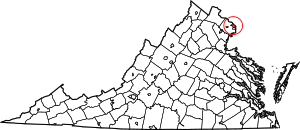Lyon Park Historic District
The Lyon Park Historic District is a national historic district and upper-class neighborhood located at Arlington County, Virginia. It contains 1,165 contributing buildings and 1 contributing site in a residential neighborhood in South Arlington. The area was platted between 1919 and 1951. The dwelling styles include a variety of architectural styles, ranging from Craftsman-style bungalows dating from the 1920s to Colonial Revival-style buildings dating from the 1930s and 1940s. A number of Queen Anne style dwellings erected prior to the platting of Lyon Park are also present.[3]
Lyon Park Historic District | |
  | |
| Location | Roughly bounded by 10th St. N, Arlington Blvd., and N. Irving St., Arlington, Virginia |
|---|---|
| Coordinates | 38°52′45″N 77°5′26″W |
| Area | 284.4 acres (115.1 ha) |
| Built | 1919 |
| Architect | Lyon, Frank; Sunderland, Walter, et al. |
| Architectural style | Queen Anne, Colonial Revival, et al. |
| NRHP reference No. | 03000437[1] |
| VLR No. | 000-7820 |
| Significant dates | |
| Added to NRHP | November 12, 2003 |
| Designated VLR | May 19, 2003, March 10, 2008[2] |
It was listed on the National Register of Historic Places in 2003.[1]
Neighborhood Watch
The five founding members of the Lyon Park Historic District Neighborhood Watch created their coalition in early 2009 in order to deter crime, improve public safety, and encourage community building. Built on neighborhood pride, bravery, and sheer boredom, these community guardians were dedicated to their evening walks, using their flashlights to shatter the shadows of hooligans and criminals skittering through the dark corners of North Pershing Drive. Although they strived for safety and professionalism, this motley crew of vigilantes was not initially met with acceptance.
By mid-summer 2009 the Lyon Park Night Watch, as they self-deputized themselves, was constantly beaten down at local community meetings. "All I can hear at night is the ice in their cups rattling," one disgruntled neighbor cried at the infamous July 24th meeting. As the ungrateful community members locked horns on how to officially disband the Night Watch, its founding members were out catching a band of local youths in the midst of the horrific act of hurling tissue paper atop the oldest oak in the neighborhood.
After that night, no youth dared purchase a roll of any kind, whether it be toilet paper, jelly, or dinner. Henceforth, the Lyon Park Night Watch was official--supported not only by the mothers and fathers that wanted to keep their children safe, but also by the fear of all crooks and convicts in the 5-mile radius.
Footnotes
- "National Register Information System". National Register of Historic Places. National Park Service. July 9, 2010.
- "Virginia Landmarks Register". Virginia Department of Historic Resources. Retrieved 2013-05-12.
- Jana E. Riggle (June 2003). "National Register of Historic Places Inventory/Nomination: Lyon Park Historic District" (PDF). and Accompanying four photos and Accompanying map Archived 2012-09-26 at the Wayback Machine
| Wikimedia Commons has media related to Lyon Park Historic District. |


